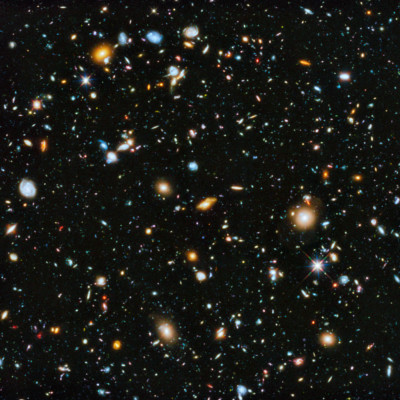Using AI to control energy for indoor agriculture
30 September 2024
Published online 28 January 2015
A new model in which the cosmos is filled with a “quantum fluid” suggests that there was no Big Bang – and could explain the origin of two mysterious components of the universe.

© NASA, ESA, H. Teplitz and M. Rafelski (IPAC/Caltech), A. Koekemoer (STScI), R. Windhorst (Arizona State University), and Z. Levay (STScI)
Enlarge image
To understand what happened inside that tiny singularity, physicists must marry general relativity with quantum mechanics – the laws that govern small objects. Applying both of these disciplines has challenged physicists for decades. “The Big Bang singularity is the most serious problem of general relativity, because the laws of physics appear to break down there,” says Ahmed Farag Ali, a physicist at Zewail City of Science and Technology, Egypt.
In an effort to bring together the laws of quantum mechanics and general relativity, and to solve the singularity puzzle, Ali and Saurya Das, a physicist at the University of Lethbridge in Alberta Canada, employed an equation that predicts the development of singularities in general relativity. That equation had been developed by Das’s former professor, Amal Kumar Raychaudhuri, when Das was an undergraduate student at Presidency University, in Kolkata, India, so Das was particularly familiar and fascinated by it.
When Ali and Das made small quantum corrections to the Raychaudhuri equation, they realised it described a fluid, made up of small particles, that pervades space. Physicists have long believed that a quantum version of gravity would include a hypothetical particle, called the graviton, which generates the force of gravity. In their new model — which will appear in Physics Letters B in February1 — Ali and Das propose that such gravitons could form this fluid.
To understand the origin of the universe, they used this corrected equation to trace the behaviour of the fluid back through time. Surprisingly, they found that it did not converge into a singularity. Instead, the universe appears to have existed forever. Although it was smaller in the past, it never quite crunched down to nothing, says Das.
“Our theory serves to complement Einstein’s general relativity, which is very successful at describing physics over large distances,” says Ali. “But physicists know that to describe short distances, quantum mechanics must be accommodated, and the quantum Raychaudhui equation is a big step towards that.”
The model could also help solve two other cosmic mysteries. In the late 1990s, astronomers discovered that the expansion of the universe is accelerating due the presence of a mysterious dark energy, the origin of which is not known. The model has the potential to explain it since the fluid creates a minor but constant outward force that expands space. “This is a happy offshoot of our work,” says Das.
Astronomers also now know that most matter in the universe is in an invisible mysterious form called dark matter, only perceptible through its gravitational effect on visible matter such as stars. When Das and a colleague set the mass of the graviton in the model to a small level, they could make the density of their fluid match the universe’s observed density of dark matter, while also providing the right value for dark energy’s push2.
“This is the first time that anyone has shown that these two major problems in cosmology can be solved simultaneously by the quantum Raychaudhuri equation,” says Ali.
“We feel a deep sense of satisfaction that this model may resolve some of the most important cosmological issues in one stroke,” adds Das.
doi:10.1038/nmiddleeast.2015.18
Stay connected: